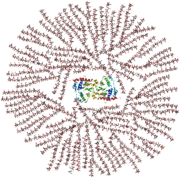Sandbox Reserved 301
From Proteopedia
| This Sandbox is Reserved from January 10, 2010, through April 10, 2011 for use in BCMB 307-Proteins course taught by Andrea Gorrell at the University of Northern British Columbia, Prince George, BC, Canada. |
To get started:
More help: Help:Editing |
Introduction
Escherichia coli Branching Enzyme (BE) (1,4-a-glucan 6-glucosyltransferase)catalyzes the formation of a-1,6 branch points of glycogen[1]. The enzyme contains three domains: a NH2-terminal seven stranded b-sandwich domain, a COOH-terminal domain, and a central a/b-barrel domain containing the enzyme active site [1]. The branching enzyme belongs to the a-amylase family of enzymes[1].
Contents |
Function
Branching Enzymes contributes to the structure of startch in plants and glycogen in animals and bacteria by catalyzing the formation of a-1,6 brach points in the polysaccharides[1]. The polysaccharide is cleaved at the a-1,4 glucosidic linkage, yidleing a non-reducing end oligosaccharide chain and subsequent attachment to the a-1,6 position[1]. Branching of polysaccharides increased the number of non-reducing ends which makes glycogen more reactive to synthesis and digestion, alos essential for assuring its solubility in the cell (as shown in Figure 1)[1].

Glyogen Storage Disease type IV
Mutations in the gene of Branching Enzyme can result in the accumulation of insoluble glycogen in the cell known as Glycogen Storage Disease type IV (GSD-IV)[1]. This results in an impaired enzyme which prevents the formation of branch points in glycogen, producing an insoluble polymer[1]. Different forms of GSD-Iv affects the liver, muscular tissue, and/or the central and peripheral nervous system[1].
Family
E. coli Branching enzyme belongs to the a-amylase family of enzymes[1]. Members of this group include a-amylase, pullulanase/isoamylase, cyclodextrin glucanotransferase (CGT), and branching enzymes[1]. Analyzing X-ray structres of a-amylase, isoamylase, CGT with the branching enzyme show that these enzymes have a common (a/b) barrel domain that contains the enzyme's catalytic centre[1].
Domains
Braching enzyme is divided in three domains based on the prediction of secondary structure and smiliarities of amylotic family of enzymes[1]. The three domains consist of an amino-terminal domain, a carboxyl-terminal domain, and a central (a/b) barrel catalytic domain [1].
Amino-Terminal Domain
The NH2-terminal domain is involved in determining the size of the chain transferred[1]. This domain helps determine the unique feature of the action of the branching enzyme lies to the specificity for the length of the glucan chain transferred. E. coli Branching Enzyme prefers to transfer shorter chains between 5 and 16 glucose units[1].
Carboxyl-Terminal Domain
The COOH-terminal domain is involved in substrate preference and catalytic capacity[1].
Central (a/b) Barrel Catalytic Domain
Based on analysis of biochemical and X-Ray structures of apo- (without a substrate bound) and substrate-bound a-amylase and CGT, the catalytic center of of these enzymes have been localized to the residues Tyr300, Asp335, His340, Arg403, Asp405, Glu458, and Asp526 in the E. coli as shown in [1]. These conserved residues are conserved among members of the a-amylase fmaily including Branching enzymes from various organisms[1]. Studies involving site-directed mutagensis an chemical motification revealed that Tyr300 and Glu459 to be conserved specifically to E.coli.
References
- ↑ 1.00 1.01 1.02 1.03 1.04 1.05 1.06 1.07 1.08 1.09 1.10 1.11 1.12 1.13 1.14 1.15 1.16 1.17 1.18 Abad MC, Binderup K, Rios-Steiner J, Arni RK, Preiss J, Geiger JH. The X-ray crystallographic structure of Escherichia coli branching enzyme. J Biol Chem. 2002 Nov 1;277(44):42164-70. Epub 2002 Aug 23. PMID:12196524 doi:10.1074/jbc.M205746200

